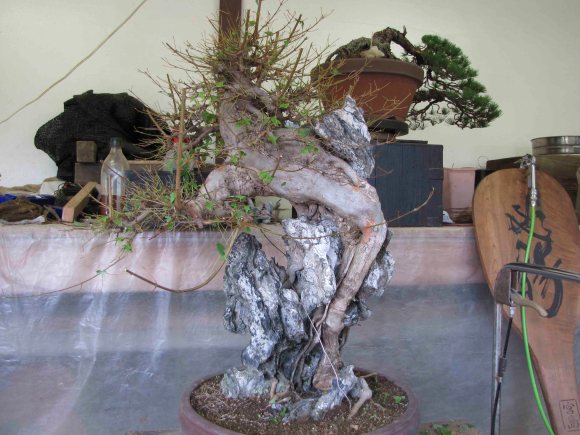For the last couple of weeks, I’ve been working on a lot of, “developing Trident Maples.” These developing Trident Maples have good size trunks, so now it’s time to develop the main and some secondary branch structures. The great thing about all these Trident’s that I’ve been working on is that they are all Root over rock Trident Maples. I’d have to admit that lifting them wasn’t too fun but each of them are truly amazing trees and I’m glad that I’m playing a part in their development. Here at Aichi-en, Japanese Black Pines are the front runner in quantity, but the Trident Maples are a close second. This works out great for me because Trident Maples are my second most favorite tree to work on. As you can see from the picture above, there is some serious ramification being developed here. But how do we get to that point? In this post, I’m going to talk about some basic concepts as to how Trident Maples grow and develop, a couple of branch selection scenarios and some before and afters shots of what I did to the overall tree. I took a lot of pictures for this post so it’s a longer one. It’s actually the longest post to date. I thought about making it a two parter but tomorrow is my day off after two weeks of nonstop work and I think I’m going to lay off the computer for the day. Here we go!
Why Trident Maples?
Trident Maples are native to China so it makes sense that they are used for Bonsai. Their leaves vary in sizes but can always be trained to become smaller if necessary. They grow fast, wounds heal quickly, buds back easily and can be developed into highly ramified trees faster then most other deciduous trees. As the tree gets older, the trunk and branches will develop muscular lumps and start shedding thin pieces of bark to reveal a beautiful patchwork of orange and grey hues. They are one of the most common deciduous trees used in Bonsai here in Japan.
 Here is an example of the trunk developing a muscular feel and some bark that has been peeled off.
Here is an example of the trunk developing a muscular feel and some bark that has been peeled off.
Growth characteristics
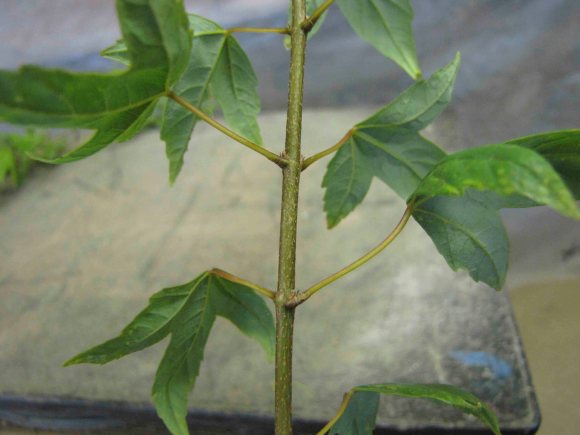 Trident Maples have two buds that are opposite one another at a single node. The following bud set will rotate about 90 degrees and so forth. If you were looking a a branch, you will see that one on set, the bud will point up and down and the following set, the buds will point left and right. These points are the only areas that will grow a branch. The spaces in between the buds (internode) will never produce a branch. That’s why you always hear people talking about short internodes.
Trident Maples have two buds that are opposite one another at a single node. The following bud set will rotate about 90 degrees and so forth. If you were looking a a branch, you will see that one on set, the bud will point up and down and the following set, the buds will point left and right. These points are the only areas that will grow a branch. The spaces in between the buds (internode) will never produce a branch. That’s why you always hear people talking about short internodes.
 Here’s a close up shot of the buds when the leaves are removed. Normally I will cut the leaves off instead of pull them off in the Summer. If you pull the leaves in the summer, sometimes it will pull the bud off the branch. I pulled the leaves off on this picture to show the bud more clearly. When you remove the leave and the new bud starts to push, the new leaves will be smaller. Not important on these trees at the moment but useful when the tree is more refined.
Here’s a close up shot of the buds when the leaves are removed. Normally I will cut the leaves off instead of pull them off in the Summer. If you pull the leaves in the summer, sometimes it will pull the bud off the branch. I pulled the leaves off on this picture to show the bud more clearly. When you remove the leave and the new bud starts to push, the new leaves will be smaller. Not important on these trees at the moment but useful when the tree is more refined.
 This is what might happen if you pull the leaves in the Summer. Note that the bud is gone. If you pull the bud off, don’t expect a branch to grow there. That is why on some old branches, just because you see a node doesn’t mean anything will back bud there.
This is what might happen if you pull the leaves in the Summer. Note that the bud is gone. If you pull the bud off, don’t expect a branch to grow there. That is why on some old branches, just because you see a node doesn’t mean anything will back bud there.
 If you didn’t already know, this is why the tree is called a Trident Maple. They have three lobs on the leaf.
If you didn’t already know, this is why the tree is called a Trident Maple. They have three lobs on the leaf.
Let’s get to work!
My task for these trees were to defoliate the tree, cut off unnecessary branches and wire the remaining branches. We didn’t do this work to all the Root over rock Tridents here in the yard because they’re all in various stages. The ones that still need to get bigger or develop thicker branches are being let go and allowed to grow for another year or more.
Aluminum wire should be used when wiring Deciduous trees. Since aluminum is softer and more flexible then copper, we have to use a much thicker wire to bend maple branches. When selecting aluminum wire sizes for a specific branch, it needs to be almost equal in size to the branch you want to bend.
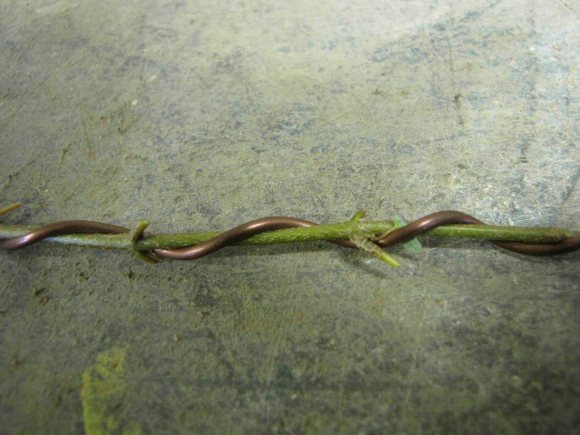 This branch is about 2mm thick so I used a 2mm thick aluminum wire. Note that the wire goes around the buds and not on top of them. If you lay wire right on a bud, it’s going to have a difficult time to grow or might die off due to pressure from the wire.
This branch is about 2mm thick so I used a 2mm thick aluminum wire. Note that the wire goes around the buds and not on top of them. If you lay wire right on a bud, it’s going to have a difficult time to grow or might die off due to pressure from the wire.
 Here is one of the first ones I worked on. You can see that the roots are very established on the rock. Now it’s time to work on the branches.
Here is one of the first ones I worked on. You can see that the roots are very established on the rock. Now it’s time to work on the branches.
 This is after I cut off all the leaves. Next, I started to cut the unwanted branches.
This is after I cut off all the leaves. Next, I started to cut the unwanted branches.
 This knuckle where many branches are growing out is not a desirable characteristic on any tree. Sometimes you can cut away some of the branches and keep two but in this case, I cut the whole knuckle off and will use either a new branch or another branch in that same area instead.
This knuckle where many branches are growing out is not a desirable characteristic on any tree. Sometimes you can cut away some of the branches and keep two but in this case, I cut the whole knuckle off and will use either a new branch or another branch in that same area instead.
 Here is the knuckle cut off. I actually cut it off to the following node point. I’m hoping that a new bud will develop and I can make a new branch in this area. After the cut, I sealed it with cut paste.
Here is the knuckle cut off. I actually cut it off to the following node point. I’m hoping that a new bud will develop and I can make a new branch in this area. After the cut, I sealed it with cut paste.
 Here’s another senario of branches that I cut. On this branch, you can see it was cut before and two buds grew branches going up and one going out.
Here’s another senario of branches that I cut. On this branch, you can see it was cut before and two buds grew branches going up and one going out.
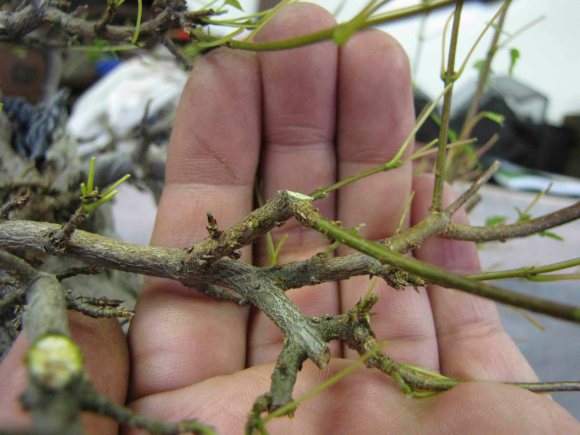 In this instances, I cut the branch growing up and kept the lower branch. When that would heals, it will become around and give the branch an interesting curve on it. For the most part though, I normally cut the lower branches off and bend the top one down. This usually gives the tree a more natural curve to the branch. I’ll get into more details of why I decided to cut the top branch off later in the post.
In this instances, I cut the branch growing up and kept the lower branch. When that would heals, it will become around and give the branch an interesting curve on it. For the most part though, I normally cut the lower branches off and bend the top one down. This usually gives the tree a more natural curve to the branch. I’ll get into more details of why I decided to cut the top branch off later in the post.
Selecting which branch to remove and keep can be tricky because there are so many variables to think off. When cutting, you always have to ask yourself these questions. Is the branch too thin or too thick for the section of the tree I’m working on? Are there multiple branches growing from one point? Is the internode in this area too long for the section of the tree I’m working on? Is there taper in the branches?
I mostly was cutting branches that were point down, cutting thick branches back to use more smaller branches to develop better taper and cleaning out areas on the trunk that were too crowded with branches. Take what you can from this post now and in the future when I work on more Trident maples and run into more specific concepts and points, I’ll share them with you. Cutting deciduous trees is difficult and cannot be learned in just one sitting, so I don’t expect anybody to learn it all in just one post. ;o)
 Here is the tree after I cut and wired it. The lower right branch needs to get thicker so I wired it and didn’t cut the tip off. The tree itself isn’t much to look at at this point. The important part is that I wired and put some bends on branches so when they thicken in the future, they will look natural and beautiful. This isn’t the first time the tree has been cut and it won’t be the last. Branches that are kept this time around might be cut off in the future in favor of a new or better branch. It’s a process, so I didn’t get too picky on every single branch. At this point, it’s all about developing the core of the tree.
Here is the tree after I cut and wired it. The lower right branch needs to get thicker so I wired it and didn’t cut the tip off. The tree itself isn’t much to look at at this point. The important part is that I wired and put some bends on branches so when they thicken in the future, they will look natural and beautiful. This isn’t the first time the tree has been cut and it won’t be the last. Branches that are kept this time around might be cut off in the future in favor of a new or better branch. It’s a process, so I didn’t get too picky on every single branch. At this point, it’s all about developing the core of the tree.
Next…
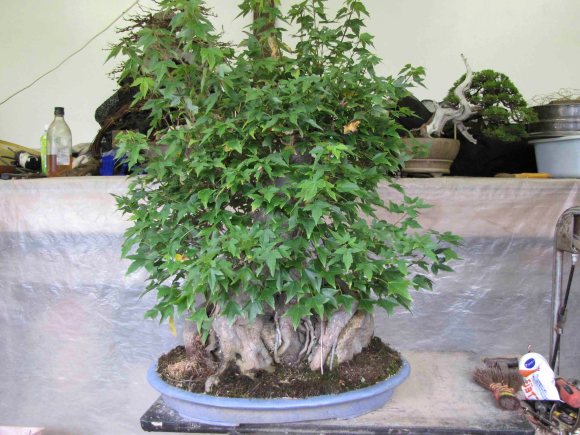 Here’s another Trident I worked on. Try to focus on this tree and not the cool little Shimpaku in the background.
Here’s another Trident I worked on. Try to focus on this tree and not the cool little Shimpaku in the background.
 This is after I pulled of the leaves.
This is after I pulled of the leaves.
 Here’s the tree after I cut and wired it. Once again, the lower branches have to get thicker. The top of this tree still needs to be developed so it looks a bit flat at the moment. Again, it’s a process.
Here’s the tree after I cut and wired it. Once again, the lower branches have to get thicker. The top of this tree still needs to be developed so it looks a bit flat at the moment. Again, it’s a process.
Next…
 This one was heavy… which brings up a good point. All the stones that are used for these are extremely dense and hard. As the roots cling to the rock, it exerts a tremendous amount of pressure on the rock. If the rock is soft, it will start to crack and piece may break off.
This one was heavy… which brings up a good point. All the stones that are used for these are extremely dense and hard. As the roots cling to the rock, it exerts a tremendous amount of pressure on the rock. If the rock is soft, it will start to crack and piece may break off.
 This tree had an interesting problem. There is a huge knuckle on the left side of the tree. There is also a branch that grew straight up from a lower branch and started to mend and connect with this knuckle because it has been in contact with it for so long. What to do?
This tree had an interesting problem. There is a huge knuckle on the left side of the tree. There is also a branch that grew straight up from a lower branch and started to mend and connect with this knuckle because it has been in contact with it for so long. What to do?
 Now it’s gone! I pretty much cut the whole thing off. The left over scar is about two inches wide but will heal over quickly. I’d say in one year, the scar will be completely covered.
Now it’s gone! I pretty much cut the whole thing off. The left over scar is about two inches wide but will heal over quickly. I’d say in one year, the scar will be completely covered.
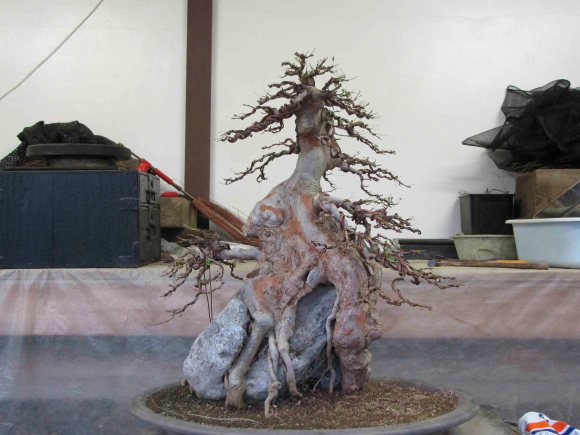 Here is the tree after more cutting and wiring. In the future, this tree will need some branches grafted to that big empty area in the middle left.
Here is the tree after more cutting and wiring. In the future, this tree will need some branches grafted to that big empty area in the middle left.
Next…
 This one is even heavier then the last!
This one is even heavier then the last!
 Here is the tree without the leaves. This is a great example of deciduous trees looking good when they have leaves and the truth coming out when the leaves are gone. Deciduous trees should look good with and without leaves.
Here is the tree without the leaves. This is a great example of deciduous trees looking good when they have leaves and the truth coming out when the leaves are gone. Deciduous trees should look good with and without leaves.
 The tree got shorter! I decided that the tree was too tall and that the top actually started to get bigger then the bottom. I’m going to grow a new top for this one. I didn’t get a chance to wire this one because I was called to work on something else. Mr. Tanaka’s helper who is also named Mr. Tanaka wired it and finished it for me. That was nice of him! Who would have thought there’d be more then one Tanaka in Japan…
The tree got shorter! I decided that the tree was too tall and that the top actually started to get bigger then the bottom. I’m going to grow a new top for this one. I didn’t get a chance to wire this one because I was called to work on something else. Mr. Tanaka’s helper who is also named Mr. Tanaka wired it and finished it for me. That was nice of him! Who would have thought there’d be more then one Tanaka in Japan…
Next…
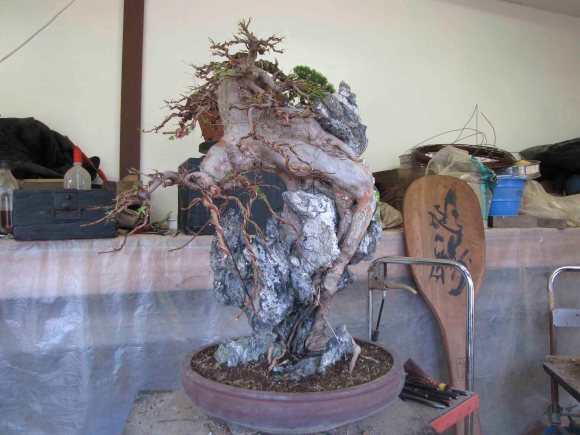 I had a little bit more fun with this tree. The lower left branch was bend straight down. I’m going to grow this one out and make something out of the ordinary. I’ll explain at the end of the post
I had a little bit more fun with this tree. The lower left branch was bend straight down. I’m going to grow this one out and make something out of the ordinary. I’ll explain at the end of the post
Next…
 This is the last Trident I worked on.
This is the last Trident I worked on.
 Here is the tree without the leaves. I haven’t wired this one yet because I stopped to write this post. :-p
Here is the tree without the leaves. I haven’t wired this one yet because I stopped to write this post. :-p
The count?
 Here is a shot of some of the Tridents I worked on. I’d say I worked on about 10 of them in the past 2 weeks. They ranged from medium to large sizes.
Here is a shot of some of the Tridents I worked on. I’d say I worked on about 10 of them in the past 2 weeks. They ranged from medium to large sizes.
The goal
What was the goal of all this work? Other then give me a great deal of practice…
 Here is an example of a more finished tree. I asked Mr. Tanaka how long this tree took to make. This is what he told me. The trunk took 20 years to create and the branch structure another 20 years. His grandfather made the trunk and his father made the branches. It took a long time! But there is good news. Mr. Tanaka added this. If he was to make one today and gave it the maximum amount of attention, it would take him about 15 years from a baby tree to a fully refined tree. Since there are so many of these trees here, they didn’t always get the full attention they needed so it makes sense that it took longer to create. Mr. Tanaka then said that it’ll take 15 years from a, “skilled professional.” He said people who lack the skills needed to create these trees can spend a lifetime and not get this kind of result. Knowledge and technique is truly the key!
Here is an example of a more finished tree. I asked Mr. Tanaka how long this tree took to make. This is what he told me. The trunk took 20 years to create and the branch structure another 20 years. His grandfather made the trunk and his father made the branches. It took a long time! But there is good news. Mr. Tanaka added this. If he was to make one today and gave it the maximum amount of attention, it would take him about 15 years from a baby tree to a fully refined tree. Since there are so many of these trees here, they didn’t always get the full attention they needed so it makes sense that it took longer to create. Mr. Tanaka then said that it’ll take 15 years from a, “skilled professional.” He said people who lack the skills needed to create these trees can spend a lifetime and not get this kind of result. Knowledge and technique is truly the key!
 Here’s another tree that was created here in Aichi-en.
Here’s another tree that was created here in Aichi-en.
The interesting and strange
 Here is a Trident Maple with an unusual branch structure. This tree was created by Mr. Tanaka’s grandfather. The entire left side of the tree is made from one large branch that is coming from the top of the tree! Was it a flaw in development? One of the things I’ve learned here at Aichi-en is to be unique and different in my work. Mr. Tanaka says it is important to know how to make a tree look good, but it’s also important to create some unusual pieces too. Most refined Trident Maples for the most part look very similar. They have nice trunks and great branch structures. Once you have a few of them, they may become dull to look at though they are great. This tree at the end will stand out from the crowd and in the long run will be remembered.
Here is a Trident Maple with an unusual branch structure. This tree was created by Mr. Tanaka’s grandfather. The entire left side of the tree is made from one large branch that is coming from the top of the tree! Was it a flaw in development? One of the things I’ve learned here at Aichi-en is to be unique and different in my work. Mr. Tanaka says it is important to know how to make a tree look good, but it’s also important to create some unusual pieces too. Most refined Trident Maples for the most part look very similar. They have nice trunks and great branch structures. Once you have a few of them, they may become dull to look at though they are great. This tree at the end will stand out from the crowd and in the long run will be remembered.
This by no means, is a reason for anybody to forgo the correct development and style of a Trident Maple. Too often I hear people talking about creating their own style in Bonsai, not because they’re trying to be creative, but because they lack the skills necessary to do it correctly. A skilled Bonsai artist should be able to do both the classic natural style and the sometimes odd styles.
This is just a part of the overall development of Trident Maples and as I continue to work and study them, I’ll be sure to pass on the info I learn to you readers. This was a long one. Are you tired? I know I am…
Thanks for reading!



